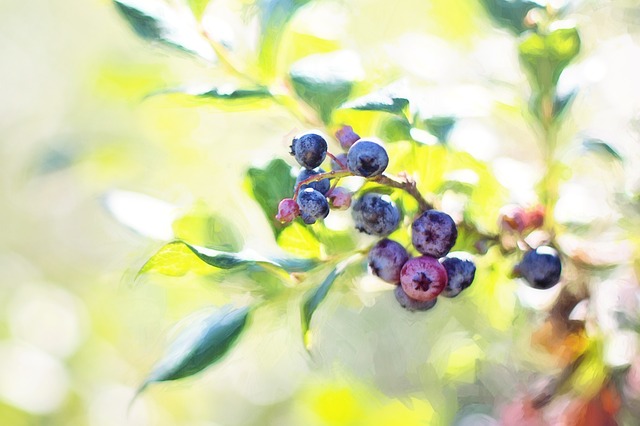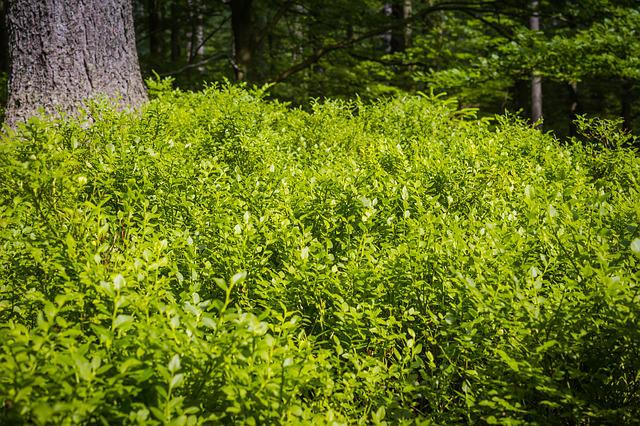When Do Blueberries Bloom?

During spring and early summer, the white, pink, or purple flowers of blueberry plants can be seen blooming on the plants. Blueberries are perennial plants, which means they can live for multiple years and bloom annually under the right conditions. Fruit typically ripens in June and August, when the blossoms give way to dark green leaves with light undersides. Seasonal color changes occur in the fall as trees and shrubs change from green to red, orange to purple, or even yellow. When you plant a blueberry bush, it will start producing fruit in two to three years. It will reach full production in six years and full size in eight to ten years, though.
Southern highbush and Northern highbush cultivars bloom from late January to early March. They produce berries that can be harvested from late May into early September. After the berry harvest, new branch and leaf growth begins and continues until the autumn colors appear from September to November. The leaves of some blueberry varieties, but not all, fall off in the late November–December period. They hibernate from December to January.
Each year, a new crop of Rabbiteye blueberry blooms in the early spring. Chill hours and warming spring weather affect when the flowers bloom in an area. The earliest blooming and fruiting varieties require the fewest chill hours, and they are also the most vulnerable to late spring frost injury. Grown in areas that don’t get enough chill hours, high-chill varieties may not produce. Consider cultivars with a chilling requirement within 150 hours of the average chilling time in your growing region (either higher or lower). It is best to purchase them from a well-known nursery.
Table of Contents
When Does a Blueberry Bush Start Producing Berries?
According to the variety, blueberry bushes can begin bearing fruit as early as June and continue to bear fruit as late as August. Spring and early summer bring the appearance of the flowers, which are white, pink, or red, and appear on the bush.
Blueberries are self-pollinating to varying degrees, but they are all self-pollinating. Remember that self-pollination does not imply that pollination will occur – more on this later.
Why Didn’t the Blueberries Bloom This Year?
There could be various factors contributing to the lack of flowers in blueberries. The following are:
Soil Condition
There could be various factors contributing to the lack of flowers in blueberries. However, while blueberries can grow in various soil conditions, they will only truly thrive in acidic soil with a pH of less than 5.5, with the ideal pH range being between 4.5 and 5. Check your soil to see if it requires any amendments. If the soil pH is greater than 5.1, elemental sulfur or aluminum sulfate should be added.
Blueberries, like the majority of plants, require soil that drains well. Even though they require consistent irrigation throughout the growing season, they do not like “wet feet.”
Sun Requirement
It is also recommended that you plant them in full sun. A shady location may prevent the plant from blossoming and, as a result, from producing fruit.
Pollination
While blueberries are self-fruitful, they will benefit from the presence of another blueberry plant near their own. If your blueberries do not produce flowers, there may be insufficient pollination.
Planting another blueberry within 100 feet (30 meters) of an existing one will encourage bees to cross-pollinate the blossoms, increasing your chances of harvesting a fruitful crop. Planting a different variety nearby may result in larger and more abundant berries in the long term.
Pests
If it appears that your blueberries are not producing fruit, you may want to reevaluate your situation. In addition to us, our feathered friends enjoy the taste of fresh blueberries. However, if you did not keep a close eye on the blueberry, the birds may have taken advantage of the ripening fruit before realizing what had happened.
Age
The age of your blueberry plant may also be a contributing factor to low or nonexistent production. Blueberries planted in their first year should have their blossoms removed. Why? If you do this, you will allow the plant to devote all of its energy to producing new foliage, which will result in improved fruit production the following year.
However, one-year-old blueberries have a high mortality rate compared to other varieties. It is preferable to plant blueberries two to three years old and has a more established root system.
Pruning
Plants that are over a decade old should be pruned. Pruning blueberries regularly is critical to their health and can impact the fruit set. The canes that produce the most fruit are not the largest. The most productive canes will be between four and eight years old and between one-and-a-half inches (2.5-4 cm) in diameter. It is preferable to have a plant that has 15-20 percent young canes that are less than an inch (2.5 cm) across, 15-20 percent older canes that are around 2 inches (5 cm) in diameter, and 50-70 percent in-between canes when you are pruning the plant. Pruning should be done when the blueberry is dormant, from the fall to spring. Cut away any low growth around the plant base and any canes that are dead or weakened. Each dormant season, you should prune the plant, removing approximately one-half to one-third of the wood from the plant.
Fertilizer
Some fertilization will likely be required for blueberries to bloom and bear fruit. Since blueberries do not absorb nitrates, the nitrogen used to grow them must be in the form of ammonium. Because the roots are easily damaged in the first year of planting, they do not fertilize the plant in its first year of growth. Application of ammonium sulfate or urea to the plant after the blueberry has flowered in the second year will increase yields and fruit quality. Just sprinkle it around the plant in a ring. Do not work it into the soil. Increase the amount of ammonium sulfate by one ounce (28 g), or 12 ounces (14 g) of urea, for each year of growth until the bush reaches its sixth year. After that, apply 8 ounces (227 g) of ammonium sulfate or 4 ounces (113 g) of urea per plant, depending on the species. A soil test will assist you in determining whether or not you require any supplemental NPK fertilizer.

